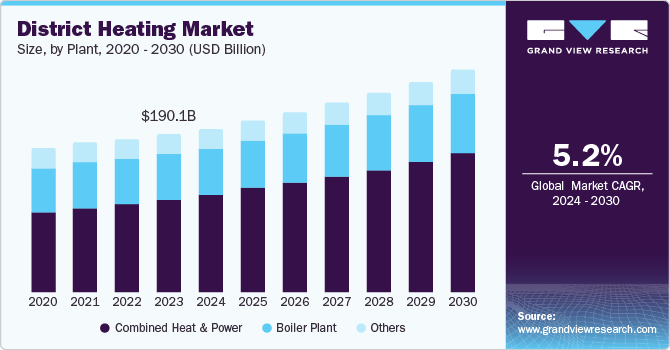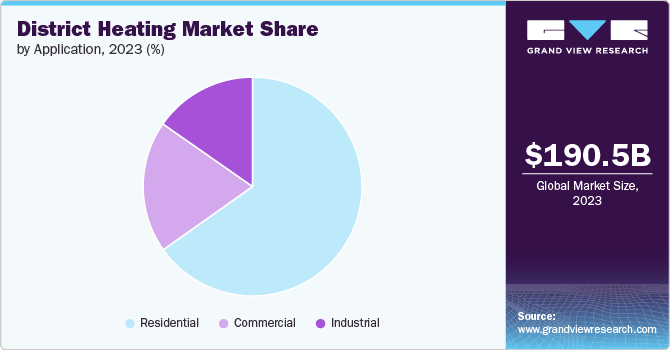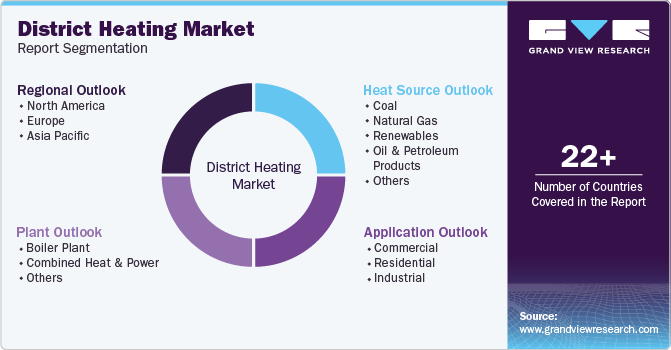
District Heating Market Size, Share & Trends Analysis Report By Heat Source (Coal, Natural Gas, Renewables), By Application (Commercial, Residential, Industrial), By Plant (Boiler Plant, Combined Heat & Power), By Region, And Segment Forecasts, 2024 - 2030
- Report ID: GVR-4-68040-365-4
- Number of Report Pages: 100
- Format: PDF, Horizon Databook
- Historical Range: 2018 - 2023
- Forecast Period: 2024 - 2030
- Industry: Advanced Materials
District Heating Market Size & Trends
The global district heating market size was valued at USD 190.5 billion in 2023 and is anticipated to grow at a CAGR of 5.2% from 2024 to 2030. Energy efficiency and sustainability are the key driving factors of the market growth. District heating systems offer efficiency gains compared to individual heating systems by utilizing waste heat from industrial processes, power generation, or renewable sources such as biomass and geothermal energy. This efficient use of heat resources not only reduces overall energy consumption but also lowers greenhouse gas emissions, aligning with global climate goals.

Increasing urbanization and densification of cities have also impacted the market positively. As urban populations grow and cities expand vertically, the demand for heating in densely populated areas intensifies. District heating systems are particularly well-suited for these environments due to their ability to serve a large number of buildings efficiently from a centralized location. This scalability makes them an attractive solution for urban planners seeking sustainable and cost-effective heating options.
Technological advancements play a crucial role in the expansion of the district heating market. Innovations in heat production, distribution networks, and heat exchange technologies have improved system reliability, efficiency, and flexibility and subsequently drive market growth.
The high initial capital investment required for building or upgrading district heating infrastructure restrain the market’s growth. The costs associated with building extensive networks of insulated pipes and installing heat generation and distribution equipment are substantial, particularly for smaller municipalities or regions with limited financial resources.
However, technological advancements offer opportunities for growth. Innovations in smart grid technologies, heat storage solutions, and digitalization are enhancing the efficiency and reliability of district heating systems. Furthermore, the integration of district heating with other energy systems such as electricity grids and thermal energy storage facilities creates opportunities for synergies and enhanced overall energy management, a lucrative opportunity for market growth.
Heat Source Insights
The demand for the renewables segment is expected to grow at a significant CAGR of 5.2% from 2024 to 2030 in terms of revenue. One of the primary drivers of the segment is the global emphasis on mitigating climate change. As countries strive to reduce greenhouse gas emissions and meet international climate targets, renewable energy sources such as biomass, solar thermal, geothermal, and waste heat recovery are increasingly favoured for their minimal carbon footprint compared to fossil fuels.
The oil & petroleum products segment accounted for 41.1% of the global revenue share in 2023 and is projected to expand at a considerable CAGR over the forecast period. One of the key drivers for using oil and petroleum products as a heat source is their high energy content per unit volume or weight, which makes them particularly suitable for applications where space and logistics are constraints. This energy density allows for compact storage and efficient transportation, facilitating their use in urban areas where space for fuel storage may be limited.
Application Insights
The residential applications segment dominated the market with a revenue share of 65.1%in 2023 and is expected to continue to grow at the highest CAGR of 5.8% over the forecast period. Urbanization and population density drive the demand for district heating in residential areas. As cities expand and become more densely populated, the concentration of buildings and energy demand is increasing. District heating systems are well-suited to serve these urban environments efficiently, leveraging economies of scale and minimizing the physical footprint of heating infrastructure compared to multiple individual heating systems. This scalability supports urban planning goals by optimizing land use and infrastructure development, thereby driving segment growth.

The commercial segment accounted for 19.5% of the market share in 2023 and displayed a sizeable CAGR at 4.1% during 2024 to 2030. One of the primary drivers for the segment is cost-effectiveness and operational efficiency. District heating systems allow commercial properties such as office buildings, hotels, hospitals, and educational institutions to benefit from centralized heat production and distribution. This centralized approach reduces energy waste associated with individual heating systems, leading to lower operational costs and improved energy efficiency.
Plant Market Trends
The Combined Heat & Power (CHP) systems captured the largest revenue share of 58.9% in 2023. CHP systems enhance energy security by providing a decentralized and reliable source of heat and power. They are particularly suitable for urban areas and commercial districts where there is a high demand for both electricity and heat. By integrating CHP into district heating networks, operators can optimize the utilization of energy resources, improve system resilience against power outages, and enhance grid stability. These benefits associated with the combined heat & power are driving segment growth.
The boiler plant segment accounted for 28.8% of the market share in 2023 and expected to grow at a CAGR of 4.5% during the forecast period. The demand for boiler plants is driven by their flexibility and cost-effectiveness in meeting varying heat demand profiles. Boiler plants can utilize a variety of fuels including natural gas, biomass, coal, and oil, providing operational flexibility and resilience against fuel price fluctuations. This versatility allows district heating operators to adapt to local fuel availability and regulatory requirements.
Regional Market Trends
Europe dominated the regional market by capturing more than 70.0% of the market share in terms of revenue in 2023 and is anticipated to expand at a fastest CAGR of 5.6% over the forecast period. The district heating market in North America is experiencing substantial growth as the region. Urbanization trends in North America are contributing to the expansion of district heating networks. As cities grow and densify, the demand for energy-efficient heating solutions rises. District heating offers a scalable and cost-effective approach to meeting this demand, particularly in urban areas where space for individual heating systems is limited.
Europe District Heating Market Trends
Europe's commitment to energy security and resilience is boosting investment in district heating. By diversifying energy sources and integrating renewable energy, district heating networks enhance energy independence and reduce reliance on imported fossil fuels. This strategic approach aligns with Europe's energy transition goals and contributes to the continent's sustainable development agenda.

The district heating market in Poland is estimated to grow at a CAGR of 6.2% over the forecast period. As Poland seeks to meet its European Union (EU) climate targets and improve air quality, district heating systems powered by renewable energy sources such as biomass, waste heat, and increasingly, solar thermal, are being promoted. Moreover, economic factors, including the cost-effectiveness of district heating compared to individual heating systems, also drive market growth in Poland. District heating offers economies of scale and reduces operational costs for consumers, making it a competitive option for both urban and rural areas.
Asia Pacific District Heating Market Trends
The rapid urbanization and modernization occurring in Asia Pacific are driving the growth of the district heating market in the region. Countries such as China, South Korea, and Japan are expanding their district heating infrastructures to meet the rising demand for heating in urban areas experiencing population growth and economic development. District heating systems in Asia Pacific often utilize a mix of conventional fuels and increasingly incorporate renewable energy sources such as solar thermal and biomass.
Key Companies & Market Share Insights
Some of the key participants in the global district heating market are Danfoss Group, Ramboll, Dall Energy, and others. Companies are aiming to develop innovative and integrated solutions through acquisitions and collaborations with other companies.
-
Danfoss offers solutions that reduce emissions, increase machine productivity, enable electrification and lower energy consumption. Its solutions are used in sectors such as refrigeration, heating, air conditioning, power conversion, motor control, industrial machinery, marine, automotive, and off- and on-highway equipment.
Key District Heating Companies:
The following are the leading companies in the district heating market. These companies collectively hold the largest market share and dictate industry trends.
- Danfoss Group
- Ramboll
- Dall Energy
- Veolia
- Helen
- Alfa Level
- GE
- Statkraft
- Uniper
- ENGIE
- FVB Energy Inc.
- Vattenfall
- Fortum
- ENGIE
- Statkraft
Recent Developments
-
In February 2024, Uniper and Evonik launched sustainable district heating project, Technical Options for Thermal Energy Recovery (TORTE) project, in Gelsenkirchen. The TORTE project is expected to feed industrial waste heat into the district heating network from isophorone production. Approximately 1,000 homes in Ruhr region are expected to be supplied by the end of this year.
District Heating Market Report Scope
|
Report Attribute |
Details |
|
Market size value in 2024 |
USD 197.5 billion |
|
Revenue forecast in 2030 |
USD 267.7 million |
|
Growth rate |
CAGR of 5.2% from 2024 to 2030 |
|
Base year for estimation |
2023 |
|
Historical data |
2018 - 2023 |
|
Forecast period |
2024 - 2030 |
|
Quantitative units |
Revenue in Billion/Million, and CAGR from 2024 to 2030 |
|
Report coverage |
Revenue forecast, company ranking, competitive landscape, growth factors, and trends |
|
Segments covered |
Heat source , application, plant and region |
|
Regional scope |
North America, Europe, Asia Pacific |
|
Country scope |
U.S., Canada, UK, Germany, France, Finland, Sweden Russia, Austria, Poland, Czech Republic, Italy, Denmark, China, Japan, South Koreas |
|
Key companies profiled |
Danfoss Group, Ramboll, Dall Energy, Veolia, Helen, Alfa Level, GE, Statkraft, Uniper, ENGIE, FVB Energy Inc. Vattenfall, Fortum, ENGIE, Statkraft |
|
Customization scope |
Free report customization (equivalent to up to 8 analysts' working days) with purchase. Addition or alteration to country, regional & segment scope. |
|
Pricing and purchase options |
Avail customized purchase options to meet your exact research needs. Explore purchase options |
Segments Covered in the Report
This report forecasts revenue growth at global, regional, and country levels and analyses the latest industry trends in each of the sub-segments from 2020 to 2030. For this study, Grand View Research has segmented the global district heating market report based on heat source, application, plant and region:

-
Heat Source Outlook (Revenue, USD Billion, 2018 - 2030)
-
Coal
-
Natural Gas
-
Renewables
-
Geothermal
-
Biomass & Biofuel
-
Others
-
-
Oil & Petroleum Products
-
Others
-
-
Application Outlook (Revenue, USD Billion, 2018 - 2030)
-
Commercial
-
Residential
-
Industrial
-
-
Regional Outlook (Revenue, USD Billion, 2018 - 2030)
-
North America
-
U.S.
-
Canada
-
-
Europe
-
UK
-
Germany
-
France
-
Finland
-
Sweden
-
Russia
-
Austria
-
Poland
-
Czech Republic
-
Italy
-
Denmark
-
-
Asia Pacific
-
Japan
-
China
-
South Korea
-
-
We are committed towards customer satisfaction, and quality service.
"The quality of research they have done for us has been excellent."




